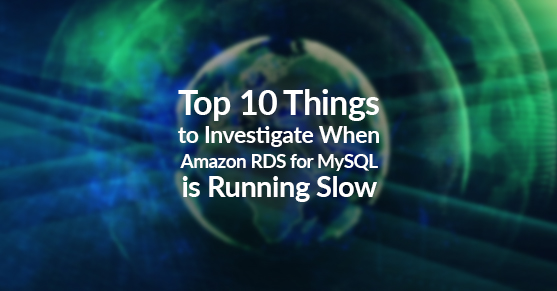As businesses rely more and more on cloud infrastructure, Amazon RDS for MySQL has become a popular choice for managing relational databases. However, despite its many benefits, like any database system, Amazon RDS for MySQL can experience performance issues. In this blog post, we’ll explore the top 10 things to investigate when Amazon RDS for MySQL is running slow or performing poorly.
1. Check for Network Latency
One of the first things to investigate when experiencing slow performance on Amazon RDS for MySQL is network latency. This can be a common cause of slow queries, especially if your application server and Amazon RDS are hosted in different regions. A tool like Pingdom can help you diagnose network issues for web applications.
2. Check for I/O Bottlenecks
Another common cause of slow performance on Amazon RDS for MySQL is I/O bottlenecks. This is often due to high write or read operations on the database. You can use the CloudWatch metrics to monitor the I/O activity and look for spikes in traffic that might be causing the bottleneck. Cloudwatch has both free and paid versions. The free version has 10 custom metrics, 10 alarms, 1,000,000 API requests, 5GB of log data ingestion and 5GB of log data archive, 3 dashboards with up to 50 metrics each per data. Depending on the size of your database, you might be able to use the free version, but if you have large databases, it would be beneficial to pay the additional charge.
Pricing will depend on many factors. You can find out more about pricing at https://aws.amazon.com/cloudwatch/pricing/.
3. Monitor CPU Usage
High CPU usage can also cause slow performance on Amazon RDS for MySQL. This can be due to queries that are using too many resources or are poorly optimized. You can use the CloudWatch metrics to monitor the CPU usage and identify which queries might be causing the issue.
4. Check for Memory Pressure
Memory pressure can cause slow performance on Amazon RDS for MySQL if the system is running low on memory. You can use the CloudWatch metrics to monitor memory usage and look for spikes that might indicate memory pressure.
5. Check for Long Running Queries
Long-running queries can also cause slow performance on Amazon RDS for MySQL. You can use the slow query log to identify these queries and optimize them to improve performance.
6. Optimize Query Cache
The query cache can become a bottleneck if it’s not configured correctly. You can use the query cache metrics to monitor its usage and optimize its configuration for better performance.
7. Optimize Table Indexes
Poorly optimized table indexes can also cause slow performance on Amazon RDS for MySQL. You can use the EXPLAIN statement to identify which queries are using inefficient indexes and optimize them.
8. Optimize Table Schema
A poorly designed table schema can also cause slow performance on Amazon RDS for MySQL. You can use the MySQL Workbench to analyze the table schema and optimize it for better performance.
9. Check for Locking Issues
Locking issues can cause slow performance on Amazon RDS for MySQL if queries are competing for resources. You can use the CloudWatch metrics to monitor the lock wait time and look for spikes that might indicate locking issues.
10. Monitor Database Connections
Excessive connections can also cause slow performance on Amazon RDS for MySQL. You can use the CloudWatch metrics to monitor the number of connections and look for spikes that might indicate a problem.
Conclusion
In conclusion, by monitoring these top 10 factors, you can diagnose and optimize performance issues with Amazon RDS for MySQL. By keeping your system optimized and efficient, you can improve the overall performance of your application and ensure that it runs smoothly for your users.
Check out our MySQL DBA Services or contact us for more information.

